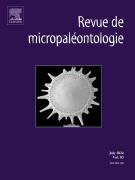A latest Carboniferous-earliest Permian palynoflora from the glacigenic Talchir Formation, Wardha Basin, central India and their biostratigraphic implications - 12/04/25
 , Ayushi Mishra a, c
, Ayushi Mishra a, cHighlights |
• | A palynological assemblage from the Talchir Formation is reported. |
• | Correlation with radiometrically constrained palynoassemblages suggests the glacigene Talchir Formation is not older than Ghzelian. |
• | Its lithological equivalents across Gondwana are also discussed. |
Abstract |
The Talchir Formation of the Gondwana Supergroup in India is a geological unit of glaciomarine/ glaciofluvial/glaciolacustrine origin that documents the glaciation that affected the supercontinent of Gondwana during the late Paleozoic. Previous spore-pollen biostratigraphy constrained the depositional age of the entire Talchir Formation to the Asselian. In this paper we present a palynological assemblage obtained from the Talchir Formation in the bore hole MAWP 114, drilled in the late Paleozoic Wardha Basin, central India. It comprises of a very rich assemblage of 79 species, of which 38 species are spores, 34 species pollen and seven species of algae. Based on the identification of radiometrically and faunally constrained biostratigraphically key species such as Vittatina spp., Converrucosisporites confluens, Pseudoreticulatispora pseudoreticulata, among others, an age not older than Gzhelian is inferred for the interval studied. The inferred age allows us to relate the Talchir deposits with the last episode of the Late Paleozoic Ice Age (LPIA). The palynological assemblage of the Talchir Formation from the present study favours its correlation with the radiometrically updated palynostratigraphic schemes established across Gondwana, on the basis of which it is constrained to the Gzhelian-early Sakmarian, encompassing the Carboniferous-Permian boundary. In India the position of the Permo-Carboniferous boundary is elusive due to lack of volcanic tuffs containing datable zircons; however, based on spore-pollen and zircon dates from Namibia this boundary is placed within the P. confluens Zone. Several taxa viz., Cristatisporites lestai, C. inconstans, C. microvacuolatus, C. crassilabratus, C. menendezii, C. stellatus, Lundbladispora braziliensis, L.riobonitensis, L.areolata, L. obsoleta, Brevitriletes leptocaina and, B. parmatus were documented for the first time in Indian Talchir sediments.
Le texte complet de cet article est disponible en PDF.Key words : Late Carboniferous-Early Permian, Palynology, Talchir Formation, Wardha Basin, India, Geochronology, Global correlation
Plan
Bienvenue sur EM-consulte, la référence des professionnels de santé.
L’accès au texte intégral de cet article nécessite un abonnement.
Déjà abonné à cette revue ?

